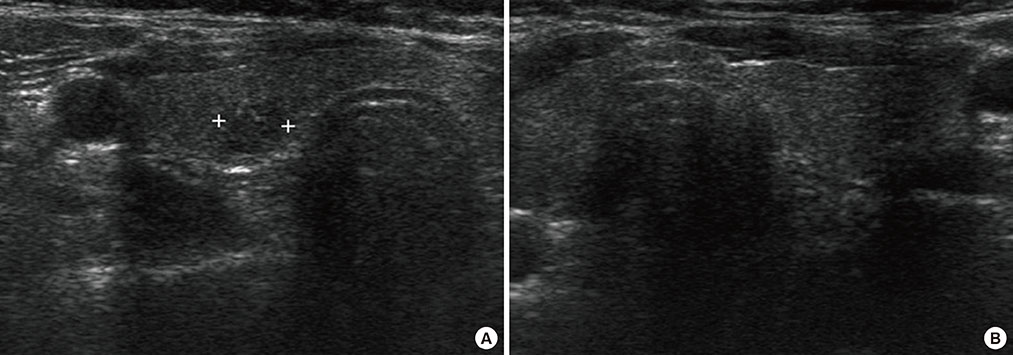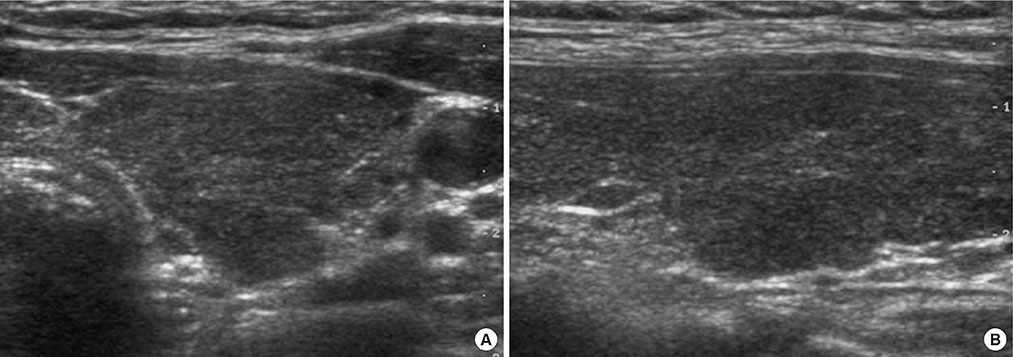Endocrinol Metab.
2013 Sep;28(3):226-230. 10.3803/EnM.2013.28.3.226.
Graves' Disease that Developed Shortly after Surgery for Thyroid Cancer
- Affiliations
-
- 1Department of Internal Medicine, Eulji University School of Medicine, Daejeon, Korea. pkkss@eulji.ac.kr
- 2Soe's Internal Medicine Clinic, Daejeon, Korea.
- KMID: 1973828
- DOI: http://doi.org/10.3803/EnM.2013.28.3.226
Abstract
- Graves' disease is an autoimmune disorder that may present with various clinical manifestations of hyperthyroidism. Patients with Graves' disease have a greater number of thyroid nodules and a higher incidence of thyroid cancer compared with patients with normal thyroid activity. However, cases in which patients are diagnosed with recurrence of Graves' disease shortly after partial thyroidectomy for thyroid cancer are very rare. Here we report a case of hyperthyroid Graves' disease that occurred after partial thyroidectomy for papillary thyroid cancer. In this case, the patient developed hyperthyroidism 9 months after right hemithyroidectomy, and antithyroglobulin autoantibody and thyroid stimulating hormone receptor stimulating autoantibody were positive. Therefore, we diagnosed Graves' disease on the basis of the laboratory test results and thyroid ultrasonography findings. The patient was treated with and maintained on antithyroid drugs. The mechanism of the recurrence of Graves' disease in this patient is still unclear. The mechanism may have been the improper response of the immune system after partial thyroidectomy. To precisely determine the mechanisms in Graves' disease after partial thyroidectomy, further studies based on a greater number of cases are needed.
MeSH Terms
Figure
Cited by 2 articles
-
Development of Thyroid-Associated Ophthalmopathy in Patients Who Underwent Total Thyroidectomy
Sun Young Jang, Ka Hyun Lee, Jong Rok Oh, Bo Yeon Kim, Jin Sook Yoon
Yonsei Med J. 2015;56(5):1389-1394. doi: 10.3349/ymj.2015.56.5.1389.Brief Review of Articles in '
Endocrinology and Metabolism ' in 2013
Won-Young Lee
Endocrinol Metab. 2014;29(3):251-256. doi: 10.3803/EnM.2014.29.3.251.
Reference
-
1. Laurberg P, Wallin G, Tallstedt L, Abraham-Nordling M, Lundell G, Torring O. TSH-receptor autoimmunity in Graves' disease after therapy with anti-thyroid drugs, surgery, or radioiodine: a 5-year prospective randomized study. Eur J Endocrinol. 2008; 158:69–75.2. Carnell NE, Valente WA. Thyroid nodules in Graves' disease: classification, characterization, and response to treatment. Thyroid. 1998; 8:647–652.3. Chung JO, Cho DH, Chung DJ, Chung MY. Ultrasonographic features of papillary thyroid carcinoma in patients with Graves' disease. Korean J Intern Med. 2010; 25:71–76.4. Dobyns BM, Sheline GE, Workman JB, Tompkins EA, McConahey WM, Becker DV. Malignant and benign neoplasms of the thyroid in patients treated for hyperthyroidism: a report of the cooperative thyrotoxicosis therapy follow-up study. J Clin Endocrinol Metab. 1974; 38:976–998.5. Pacini F, Elisei R, Di Coscio GC, Anelli S, Macchia E, Concetti R, Miccoli P, Arganini M, Pinchera A. Thyroid carcinoma in thyrotoxic patients treated by surgery. J Endocrinol Invest. 1988; 11:107–112.6. Umena S, Takano T, Iijima T, Hidaka Y, Yagoro A, Takai S, Amino N. A case of repeated painless thyroiditis followed by Graves' disease. Endocr J. 1995; 42:821–826.7. Kasuga Y, Kobayashi S, Fujimori M, Shingu K, Hama Y, Ito K, Amano J. Development of Graves' disease after surgical treatment for thyroid nodules: report of four cases. Endocr J. 1997; 44:567–570.8. Tamai H, Hirota Y, Matsuzuka F, Kuma K, Nagataki S. Three cases developed Graves' disease after surgical treatment for thyroid carcinomas. Horumon To Rinsho. 1982; 30:124–125.9. Nagai K, Tamai H, Matsubayashi S, Takaichi Y, Matsuzuka F, Kobayashi A, Hirai K, Kuma K, Nagataki S. A case developed Graves' disease after thyroid nodule. Horumon To Rinsho. 1987; 35:107–109.10. Collins J, Gough S. Autoimmunity in thyroid disease. Eur J Nucl Med Mol Imaging. 2002; 29:Suppl 2. S417–S424.11. Misaki T, Iwata M, Kasagi K, Iida Y, Akamizu T, Kosugi S, Konishi J. Hyperthyroid Graves' disease after hemithyroidectomy for papillary carcinoma: report of three cases. Endocr J. 2000; 47:191–195.12. Cho BY, Oh SK, Shong YK, Kim SE, Yoo HY, Lee HK, Koh CS, Min HK. Changes in thyrotropin receptor antibody after subtotal thyroidectomy in Graves' disease: comparison with the degree of lymphocytic infiltration in the thyroid. Autoimmunity. 1990; 8:143–147.13. De Bruin TW, Patwardhan NA, Brown RS, Braverman LE. Graves' disease: changes in TSH receptor and anti-microsomal antibodies after thyroidectomy. Clin Exp Immunol. 1988; 72:481–485.14. Volpe R. Autoimmune diseases of the endocrine system. Boca Raton: CRC Press;1990. Chapter 4, Immunology of the thyroid. p. 73–239.15. Teng CS, Yeung RT, Khoo RK, Alagaratnam TT. A prospective study of the changes in thyrotropin binding inhibitory immunoglobulins in Graves' disease treated by subtotal thyroidectomy or radioactive iodine. J Clin Endocrinol Metab. 1980; 50:1005–1010.16. Nakamura S, Ishiyama-Takuno M, Kosaka J, Kondo K, Horiya Y, Hara S, Shima H, Shiraki T. A case of Graves' disease and papillary thyroid carcinoma with predominant production of thyroid-stimulation-blocking antibodies (TSBAb) persisted after total thyroidectomy. Endocrinol Jpn. 1992; 39:133–139.17. Kiecolt-Glaser JK, Page GG, Marucha PT, MacCallum RC, Glaser R. Psychological influences on surgical recovery: perspectives from psychoneuroimmunology. Am Psychol. 1998; 53:1209–1218.18. Bauer M. Anesthesia and perioperative immune function. Remarks on the work of M. Bauer, H. Rensing and T. Ziegenfuss (Anaesthesist 1998,47:538-556). Anaesthesist. 1998; 47:939.19. Chung JH. Genetics of Graves' disease. J Korean Soc Endocrinol. 2003; 18:5–11.20. Iwatani Y, Amino N, Kaneda T, Ichihara K, Tamaki H, Tachi J, Matsuzuka F, Fukata S, Kuma K, Miyai K. Marked increase of CD5 + B cells in hyperthyroid Graves' disease. Clin Exp Immunol. 1989; 78:196–200.
- Full Text Links
- Actions
-
Cited
- CITED
-
- Close
- Share
- Similar articles
-
- Three Cases of Papillary Thyroid Carcinoma Coexistent with Graves' Disease
- Carcinoma of the thyroid gland in patients with Graves' disease
- A Case of Graves' Disease Showing a Triad of Ophthalmopathy, Pretibial Myxedema and Thyroid Acropachy
- Development of Graves' Ophthalmopathy after Radioactive Iodine Ablation Using Recombinant Human Thyrotropin for Incidentally Discovered Papillary Thyroid Carcinoma
- A Case of Graves' Disease Following Subacute Thyroiditis




